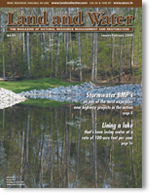Features Available Online
Caltrans' Commitment to Water Quality –
Road Realignment/Creek Restoration
by Katherine Brown and Joanne LaFave, Caltrans
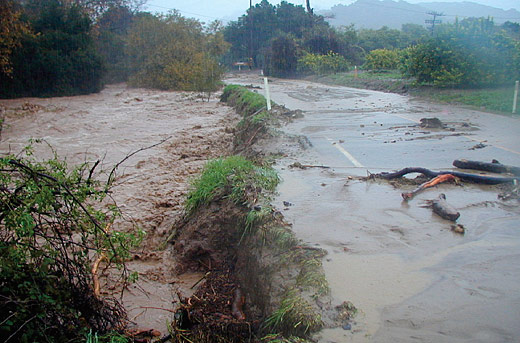
During the winter of 2005, the old alignment of State
Route 150 was flooded and closed for emergency repair.
The Rincon Creek valley in California is sparsely developed with orchards, farmlands and ranchlands, and virtually shapes the boundary between the coastal counties of Santa Barbara and Ventura. Rincon is one of the few semi-permanent creeks in the area, and was likely a freshwater source for Native Americans. Both Santa Barbara and Ventura Counties have designated the riparian corridor along the creek as an Environmentally Sensitive Habitat Area. As part of the California Department of Transportation's (Caltrans) original proposed bridge replacement and roadway realignment project along State Route 150, two existing pony truss type single lane bridges would be removed and replaced with two-lane bridges. Also, rock weirs would be constructed to allow for upstream migration of anadromous steelhead trout. The old alignment was continuously subjected to flooding, erosion and closures during storm events. The project was intended to prevent further and future disruptions to the traveling public, enhance the safety of the roadway, allow safer travel for bicyclists and other road users and at the same time, reduce impacts to the environment.
During the winter of 2005, one of the bridges was washed away and the other damaged, thus replacing both bridges became a priority and an emergency project for Caltrans. With concerns for the environment and the coastal/rural location, the project was designed using context sensitive solutions with the aim of restoring the riparian areas and returning the creek to its natural setting. The new alignment moved the roadway further inland, which allowed for greater filtering of runoff through vegetated swales. This promoted infiltration and pollutant removal thereby lessening the impacts to Rincon Creek and the surrounding wetlands. This improvement would render the highway less susceptible to flooding, erosion and help insure the highway's continued use during storm events. The new alignment also moved the road further away from large native oak trees, which contributed to the preservation of this valued community resource.
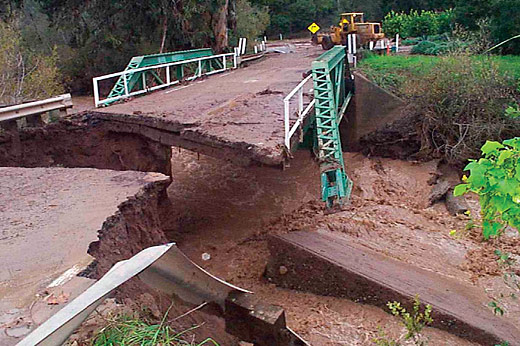
State Route 150 bridge at Rincon Creek was washed awayduring a winter storm in 2005.
All drainage systems were upgraded to meet current hydraulic standards. The contractor, Security Paving Company Inc., controlled temporary construction site water quality impacts by the strict adherence to Caltrans' Standard Specifications contained in the National Pollutant Discharge Elimination (NPDES) permit. The Storm Water Pollution Prevention Plan (SWPPP) contained a schedule detailing the implementation of Best Management Practices (BMPs) soil stabilization/sediment control measures in coordination with the various construction operations and staging. One challenge was to install 3 clear water diversions and maintain them during the various phases of work while the creek was flowing. For this reason, scheduling for construction was timed during the least amount of rainfall, between April to October. Project design also incorporated design pollution prevention BMPs as permanent water pollution prevention features. These included stabilized vegetative storm water conveyances, velocity dissipation/outlet protection, preservation of existing vegetation, slope rounding, vegetative stream bank stabilization measures and maintaining sheet flow through vegetation as much as was possible. According to the District 5 NPDES Permit Coordinator, Pete Riegelhuth, these design pollution prevention techniques "acted to stem a historical tide of pollutants, from this site, into a very sensitive ecosystem and highlights the Departments commitment to environmental stewardship."
Mitigation for the loss of native plant material was also an integral design pollution prevention component of the Rincon Creek restoration project, which included native oak, walnut, cottonwood, white alder, and sycamore trees. The design team used an innovative method of brushlayering/bioengineering at the ends of the bridge's rock slope protection (RSP) and at a narrow portion of the stream. Caltrans traditional approach to stream bank stabilization has been to use standard methods like rock slope protection. This is one of the first times a brush layering vegetative technique was incorporated into a Caltrans biddable contract.
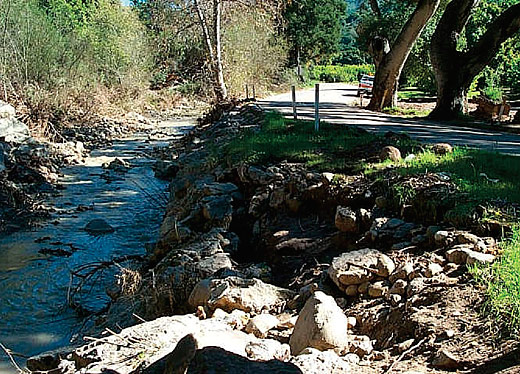
Before, State Route 150 was continuosly subjected to flooding, erosion and closures during storm events.
Brush layering was approximately 196 feet in length and consisted of placing layers of locally harvested willow cuttings (Salix lasiolepis-Arroyo Willow) and soil wrap (100% spun coir fiber netting) during embankment construction. Local willow cuttings were harvested from an area within a 5-mile radius of the project site. Cuttings from healthy vigorous plants were taken with lengths ranging from 5-10 feet and diameters ranging from 7/8-2 inches at the base of each cutting. Cuttings were kept wet and shaded until installation.
Soil wrap work consisted of placing and wrapping fill material with netting in approximately five, 30 inches layers on top of a keyed-rock slope protection installed from 10 to 20 degree angle. The leading edge of the netting was stapled in place using a minimum 11 gage steel wire u-shaped staples and allowed to lay over the embankment face while fill material (Imported topsoil) was placed on top of the netting. After placing the fill material, the netting was pulled-up and over the top of the fill and fastened in place with staples at about 2 feet intervals. Adjacent pieces of netting were overlapped a minimum of 6 inches and fastened with staples perpendicular to the slope. Prior to placing cutting, soil wrap was thoroughly moistened to a depth of 8 inches. Cuttings were placed in 4 inches thick layers with a minimum of about 30 cuttings per linear foot with minor criss-crossing. Butt ends of cuttings were placed in the embankment with the leafy ends protruding 6-12 inches from the embankment. The cuttings and soil wrap materials were placed in alternate layers and compacted with a minimum of 6 inches of fill, which remained between the equipment and the cutting for protection. Environmental guidelines and restrictions for the harvesting of cuttings were specified in the contract and monitored during construction.
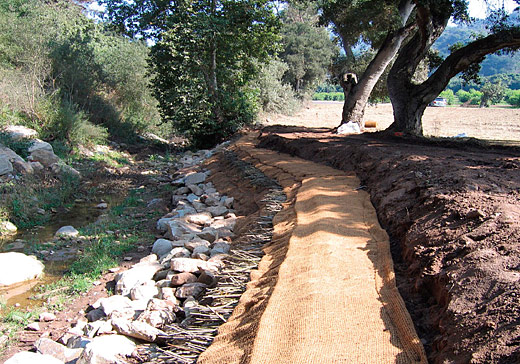
The design team used an innovative method of brushlayering/bioengineering along RinconCreek.
The revegetation of the creek not only armored the stream bank, but it also shaded the south side of Rincon Creek and improved habitat for potential migrating steelhead by providing overhanging vegetation for cover and promoted oxygenated and cooler water temperatures. According to a letter provided by the US Department of the Interior, "the combined actions reduce or eliminate sloughing of bank material into Rincon Creek and improve fisheries habitat and water quality. Reduced sedimentation is particularly beneficial for anadromous steelhead, which require gravel to cobble substrate with little or no silt for spawning." In addition to the environmental requirements for wetland, riparian, and upland habitat mitigation, Caltrans hired an arborist to supervise the pruning of oak and other native trees, and was able to protect approximately 120 native acorn seedlings found on site. Caltrans also hired a bird monitor to avoid impacts to breeding/nesting birds within and adjacent to the project site during construction of the project. One year after completion, the restoration project contributes to the area's rural feel and is aesthetically pleasing. Due to the sensitive habitat status of the area and to further insure the success of the project, Caltrans will continue to maintain the woodland and wetland revegetation areas for a period of five years with an additional three years of monitoring performed.
The design team from Caltrans included departments from Landscape Architecture, Environmental Planning, NPDES/Stormwater, Hydraulics, Engineering, and Construction. Partnering between Caltrans and the contractor was implemented and it was evident throughout the project that quality and reducing environmental impacts were key objectives. Despite the challenges of negotiating the use of this unusual mix of both RSP and planting techniques to protect Rincon Creek bank, as well as the use of non-standard details and specifications, the team succeeded in providing a successful solution to restoring this riparian area. Overall, the innovative design and engineering methods used in the Rincon Creek project have proven positive results environmentally, hydraulically and visually. Caltrans' commitment to the Rincon Creek Bridge replacement project is but one example of its dedication to serve the public and protect California's water quality and its natural resources. L&W
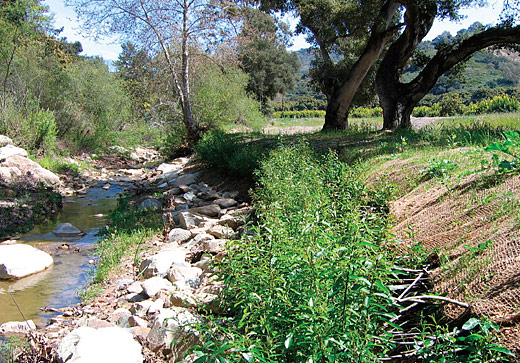
Approximately 1 1/2 years after completion, the innovative brushlayering/bioengineeringdesign methods have proven positive results environmentally, hydraulically and visually.
Caltrans is continuing to explore various options for providing vegetative enhancements and softer treatments for stream-bank stabilization. Until more extensive performance data is generated on the various techniques commonly used in stream restoration applications, Caltrans will continue to pilot a number of projects in varying hydraulic, climatic, and environmental conditions so that uniform standards can be adopted and published. Long-term evaluation of sites, such as Rincon Creek, will be instrumental in establishing the basis of these future standards that balance the environmental stewardship with protection of public safety and infrastructure.
![]()
For more information contact Katherine Brown at (805)549-3195 or e-mail Katherine_l_brown@dot.ca.gov.

